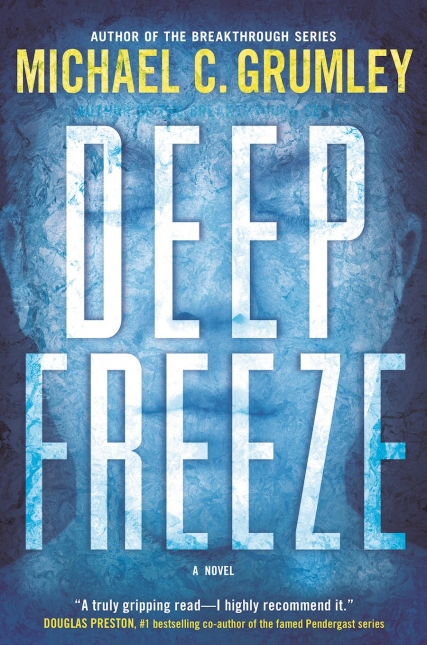Deep Freeze: A Novel
- By Michael C. Grumley
- Forge Books
- 336 pp.
- Reviewed by Lawrence De Maria
- January 15, 2024
This promising thriller ends up leaving readers cold.

When reading Michael C. Grumley’s Deep Freeze, I couldn’t help but recall the 1973 Woody Allen movie, “Sleeper,” in which the character played by Allen is revived after being frozen for 200 years. The poor schlep now inhabits a world where doctors smoke and eat cheeseburgers because it’s been discovered that such things are good for you.
Of course, Allen and Grumley aside, cryogenics is serious business. Preserving the bodies of people who’ve died of horrible diseases with the goal of bringing them back to life once cures are found is a noble undertaking. In fact, there are many such popsicle people already occupying ultra-cold tubes in facilities around the world.
Grumley, the author of the Breakthrough series, is certainly a good writer. His previous novels have more positive reviews than I have brain synapses, and his latest has been lauded by fellow thriller writers. (The question of blurbs’ reliability is best left for another time — or perhaps to science.)
But Deep Freeze, the first installment in his new Revival series, left me cold; I just could not warm up to it. Perhaps it was the glacial pacing. (Okay, I’ll stop.) The book has so much unrealized potential. Its main premise is solid. The setup and the characters are strong. But then the plot slides off the rails amid a flurry of unnecessary tangents.
Now, I don’t usually mind tangents. When used selectively, they can flesh out characters and scenes. But Grumley goes off on far too many: anti-government, survivalism, cyberwar, the AI-fueled collapse of society, funny money, and a world reduced to bartering. (Hopefully, he’ll narrow his focus in the series’ second book.)
It wasn’t too hard to figure out when and why our hero, John Reiff, was frozen. And the science of successfully freezing and thawing the Army veteran was certainly interesting. It’s something we can’t yet do, mainly because human cells have a nasty habit of breaking apart with ice crystals. Some very simple animals have a sort of antifreeze in their blood, but we don’t. Grumley solves this problem with a “machine.” I’m not sure how it works, nor is the author, who seems more interested in the nasty people who’ve kept Reiff frozen for 22 years than he is in the technology behind the feat.
Not everyone in the book is a villain, however. Reiff is primarily aided by Rachel Souza, a physician who monitors his survival while growing increasingly suspicious of the people she works for. He is also helped by a few Army buddy survivalist types who come to his rescue, guns blazing. Apparently, Reiff was some sort of super soldier before he died (or whatever) when the bus he was riding in plunged into an icy river.
It’s unclear if Reiff was ever really dead, so I’m not sure the novel’s endless palaver about declining body temperatures — both his and that of various mice, chimps, and a capuchin monkey — is entirely relevant. At least the narrative offers murders galore, but there’s little or no sex, which might’ve warmed things up. Is everyone frigid (sorry) in the future? If they are, why try for immortality?
Oh, yes. Immortality. It seems the scientists overseeing Reiff’s eventual reawakening don’t just want to freeze bodies awaiting disease cures — they want to use cryogenics to stop the aging process in healthy people, too. If they’re successful, such folks could be woken up (or is it defrosted?) far in the future. A kind of time travel for those rich enough to afford it.
Needless to say, I preferred the Woody Allen film.
Lawrence De Maria loves cheeseburgers and writes non-complicated thrillers. His heroes and villains sometimes have ice in their veins, but not antifreeze.
